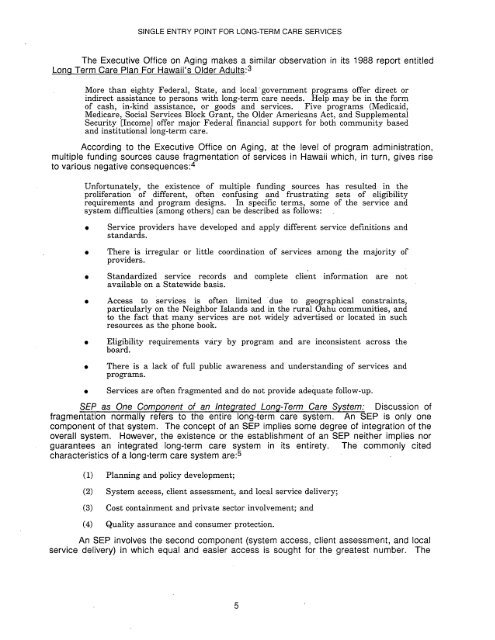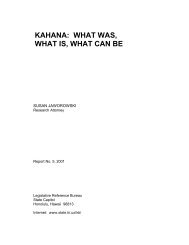long-term care - Legislative Reference Bureau
long-term care - Legislative Reference Bureau
long-term care - Legislative Reference Bureau
You also want an ePaper? Increase the reach of your titles
YUMPU automatically turns print PDFs into web optimized ePapers that Google loves.
SINGLE ENTRY POINT FOR LONG-TERM CARE SERVICES<br />
The Executive Office on Aging makes a similar observation in its 1988 report entitled<br />
Long Term Care Plan For Hawaii's Older Adults: 3<br />
More than eighty Federal, State, and local' government programs offer direct or<br />
indirect assistance to persons with <strong>long</strong>-<strong>term</strong> <strong>care</strong> needs. Help may be in the form<br />
of cash, in-kind assistance, or goods and services. Five programs (Medicaid,<br />
Medi<strong>care</strong>, Social Services Block Grant, the Older Americans Act, and Supplemental<br />
Security [Income] offer major Federal financial support for both community based<br />
and institutional <strong>long</strong>-<strong>term</strong> <strong>care</strong>.<br />
According to the Executive Office on Aging, at the level of program administration,<br />
multiple funding sources cause fragmentation of services in Hawaii which, in turn, gives rise<br />
to various negative consequences: 4<br />
Unfortunately, the existence of multiple funding sources has resulted in the<br />
proliferation of different, often confusing and frustrating sets of eligibility<br />
requirements and program designs. In specific <strong>term</strong>s, some of the service and<br />
system difficulties [among others] can be described as follows:<br />
• Service providers have developed and apply different service definitions and<br />
standards.<br />
• There is irregular or little coordination of services among the majority of<br />
providers.<br />
• Standardized service records and complete client information are not<br />
available on a Statewide basis.<br />
• Access to services is often limited . due to geographical constraints,<br />
particularly on the Neighbor Islands and in the rural Oahu communities, and<br />
to the fact that many services are not widely advertised or located in such<br />
resources as the phone book.<br />
• Eligibility requirements vary by program and are inconsistent across the<br />
board.<br />
• There is a lack of full public awareness and understanding of services and<br />
programs.<br />
• Services are often fragmented and do not provide adequate follow-up.<br />
SEP as One Component of an Integrated Long-Term Care System: Discussion of<br />
fragmentation normally refers to the entire <strong>long</strong>-<strong>term</strong> <strong>care</strong> system. An SEP is only one<br />
component of that system. The concept of an SEP implies some degree of integration of the<br />
overall system. However, the existence or the establishment of an SEP neither implies nor<br />
guarantees an integrated <strong>long</strong>-<strong>term</strong> <strong>care</strong> system in its entirety. The commonly cited<br />
characteristics of a <strong>long</strong>-<strong>term</strong> <strong>care</strong> system are: 5<br />
(1) Planning and policy development;<br />
(2) System access, client assessment, and local service delivery;<br />
(3) Cost containment and private sector involvement; and<br />
(4) Quality assurance and consumer protection.<br />
An SEP involves the second component (system access, client assessment, and local<br />
service delivery) in which equal and easier access is sought for the greatest number. The<br />
5
















